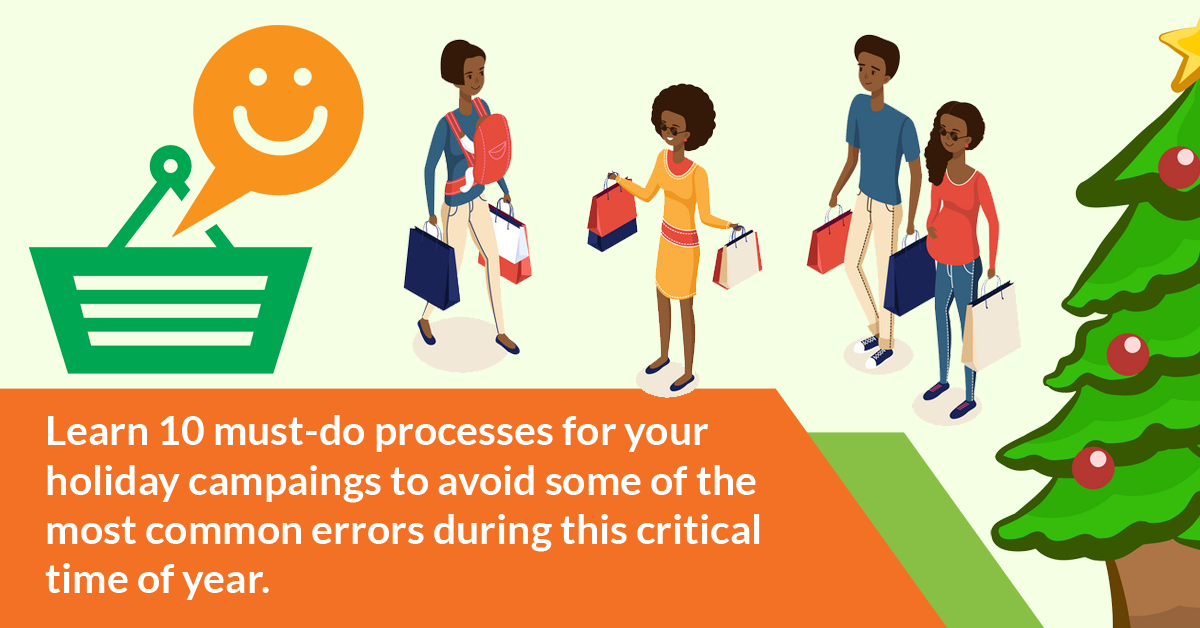
You’ve spent weeks getting your holiday campaigns wired and ready to go, coming up with irresistible offers and ways to draw in both loyal customers and brand new prospects.
And with Black Friday, Cyber Monday, and the entire holiday shopping season right around the corner, it’s almost time to launch those holiday campaigns and watch what happens.
But it’s not time to pull the trigger just yet. Before you start bringing people into your store, before you begin engaging with customers, you need to make sure all systems are go.
There’s nothing worse than launching a campaign with technological glitches and errors. Maybe a customer gets the wrong email for their stage in the Customer Value Journey, presenting an offer they aren’t sufficiently primed for.
Maybe there’s a hole in your funnel where a landing page or thank-you page should be, taking customers to the dreaded 440 page instead of the next phase of their buying experience.
Or maybe an angry customer calls you wondering where their order is because it’s three days before Christmas and it isn’t here yet…all because you didn’t clearly communicate when their order would be shipped.
The holiday season brings with it untold opportunities for success in your company. But there are also multiple ways it can all go wrong with one completely preventable mistake.
And that’s where our Ultimate Holiday Campaign Checklist comes in.
We’ve compiled our 10 must-do processes to make sure everything in your holiday campaigns is all set to go and avoid some of the most common errors that can lead to bad customer experiences and lost sales during this critical time of year.
You’ve worked too hard to have anything less than merry holiday sales—and your customers deserve it, too.
1. Did you test all your offers?

Imagine coming across the perfect holiday deal on the perfect gift for a loved one. You experience the euphoria and accomplishment of being able to cross another name off your shopping list. The dopamine rush that comes with shopping is firing up. You click the BUY NOW button, all set to do the thing…
…and nothing happens.
Two things just happened here for your company as a result of this customer experience. Obviously, you just lost a sale, which is bad enough.
But more importantly, you might have a customer service horror story on your hands…and that person is probably never going to visit your store again.
Before you launch any of your holiday campaigns or promos, you have to take them for a test drive.
This means running every email campaign to make sure that the right emails have the right content and are delivered to the right customers.
It also means ensuring that your landing pages, pop-up boxes, and thank-you pages all lead where they are supposed to in order to transport the customer through the buying experience.
With the amount of traffic coming through your site during the holidays, the last thing you need is careless errors in your marketing. A little time spent with a dry run goes a long way to avoiding malfunctions and making happier customers.
2. Have you clearly communicated your shipping and return policies?
What’s just as important to your customers as the physical products they buy online? How soon it will get to their doorstep and how much they’ll have to pay for it to get there.
Free shipping is a hypnotic trigger phrase that causes people to buy like crazy. A study by Wharton University of Pennslyvania discovered that customers will spend as much as 30% more in order to qualify for free shipping.
This means that if you can offer free shipping, and better yet, quick delivery, you’ll automatically be more likely to win people over.
This also means that before the season kicks off, you need to check that the shipping policies for your holiday campaigns are clearly communicated.
Next to broken or poorly constructed landing pages or emails, nothing deflates the enthusiasm of making a purchase quite like going through checkout and getting hit with unexpected shipping costs. In fact, this causes an increase in cart abandonment.
To prevent this, you need to explain what your policy on free shipping is—does it apply to every order, or is there a minimum purchase amount people need to qualify for free shipping? Furthermore, how soon can they expect their purchases to arrive?
People who are buying gifts online need to be able to plan for them to be there in time for the holidays, especially if they’re buying last minute—but we’ll get to that later.
You also need to clearly outline your return policy. Buyers want to shop with confidence, and knowing that there is a low risk to their purchase can significantly impact your conversion rate in a positive way.
Make sure that your policy is clearly spelled out during checkout as well as in the thank-you email they receive after making their purchase.
3. Have you analyzed your conversion path?

It’s sad to say, but it’s the truth: 95% of first-time visitors to an online store don’t convert. For most, it takes 3 or 4 additional visits for them to make a purchase.
It’s nothing against you. You have a LOT of competition—not just in stores within your vertical, but from the Internet in general. Your customers are getting pulled this way and that on a daily basis, from social media to shopping for gifts to paying bills, and this divided attention only increases during the holidays.
So what are you going to do to set yourself apart from those distractions? Ensure that you’ve crafted a path to building a relationship with customers that leads them to want to buy.
Use Google Analytics to observe how long it takes new visitors to buy and be ready to make modifications along the way to decrease that length of time. You may find that you need to include more follow-up opportunities, such as retargeting campaigns or emails with new offers, or a better means of capturing lead information through lead magnets or pop-up boxes.
4. Are your websites and promotions mobile-friendly?
One reason why Cyber Monday has become such a big deal during the holiday shopping season is that the majority of shoppers make purchases via their smartphones.
Studies have shown that holiday shopping and phones are the perfect match—people love the convenience of literally having their gift-buying experience right at their fingertips.
If your website isn’t optimized for cellphone viewing, you could be making what should be an easy task for shoppers more confusing and difficult.
For instance, you don’t want shoppers to have to constantly reposition their phone to see the entire page. You also don’t want to have call-to-action buttons and links showing up in odd positions all over the phone screen, even if they are perfectly aligned on a desktop version of the same site.
Use your web design software to test the site in mobile-view and make adjustments to your main site if necessary.
5. Do you have a strategy for ad-bidding?
The holiday season means more competition for the viewing of your Facebook ads and higher costs. Bids will increase—some businesses will have to continuously increase their bid amount to keep up with their competitors, which can quickly become overwhelming.
Analyze your current ad strategy to make sure you are able to bid more in the right places according to your existing metrics on products and conversion rates. This will help you put your money where you are most likely to win.
6. Have you developed clickable, shareable social media content?

Who doesn’t love shopping online and seeing websites decked out for the holidays? It goes without saying that you should have a friendly, festive color scheme with engaging images of your products.
What’s even more important, though, is your social media content. Your social media content isn’t just about promoting your products—it’s about getting visitors to actively engage with your brand.
The more people like and share your images, the more they spread not only the word about your product or service, but also the contagious holiday joy that comes with shopping.
Another must for engaging people on social media is to have your company’s very own holiday hashtag. Include it in your posts and encourage people to share them using the hashtag themselves.
The hashtag can also be a cool way to get customers and prospects interacting with you online. Ask them to take photos of their purchases using the hashtag or offer a prize for the most creative holiday slogan for the company.
Regardless of what unique touches you add, make sure you’ve got all kinds of creative content lined up for your social media and website.
7. Have you double-checked your inventory and shipping time frame?
Gaps and inaccuracies in your inventory can lead to customer service nightmares for customers expecting to purchase an item, only to learn a few days later that it’s out of stock.
By this point, your inventory system should be equipped to handle the high volume of the holiday season, but making sure what’s in your system matches what’s on your shelf is a critical precaution.
8. Do you have shipping options for last-minute shoppers?
Similarly, make sure your shipping speed and arrival times are kept accurate, especially to give plenty of options to last-minute buyers. One of the busiest shopping days of the year behind Black Friday and Cyber Money is the Saturday before Christmas, also known as Super Saturday.
In fact, according to the National Retail Federation, 56% of American consumers say that they shop on this day. A different survey showed that 70% of people between the ages of 18-24 wait until the week before Christmas to do their shopping.
Therefore, make sure that all of your information about when they expect their orders to ship and arrive is accurate, up to and including the days leading up to Christmas.
9. Did you test your checkout process?

Checkout is where the magic happens. It’s the moment of truth where you find out if your offers really turn people into customers. But magic can’t happen if there are glitches in your checkout process or if there are gaps in it.
To find out if your checkout process is functioning as it should be, use the Checkout Behavior Analysis feature in Google Analytics. This will demonstrate for you where barriers to purchase occur and where buyers tend to abandon their purchases. Once you get to the bottom of where any issues are happening, you can fix them in time for the holiday season to get underway.
Regardless, cart abandonments will happen. And when they do, you’ll want to be ready with a retargeting campaign to follow up with people who put items in their cart, but never began or completed the checkout process. Make sure your holiday campaigns are able to get in touch with these customers to continue the purchase process.
10. Do you have a way for customers to provide feedback?

Of all the items on our holiday campaigns checklist, this is probably the most important. Getting feedback from customers is the best way to know what is and is not working in your online experience, and because there is so much traffic to your store during the holidays, this season is a great time to solicit comments.
Give customers a chance to complete a survey to get an extra coupon or additional incentive for providing feedback, then review customer responses to get ideas for the next year and see what suggestions might have a positive effect.
Pay attention as well to the strategies that have the biggest impact on sales, as they make be ideas you can implement in the new year, not just the next time the holidays roll around.
If you’re looking for new ways to create awareness of your product or service, get new customers to engage, and turn strangers to your business into raving fans, Cirius Marketing is ready to partner with you to do it.
Our free Double Your Sales Review strategy session will show you what’s currently working in your business and which of our 73 ways to double your sales could go to work for you right now.
Just click here to grab some time on our calendar! We look forward to helping your business win!
